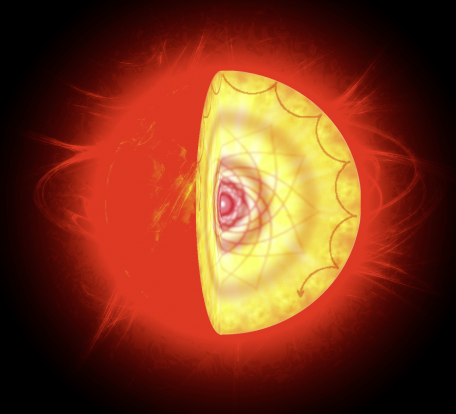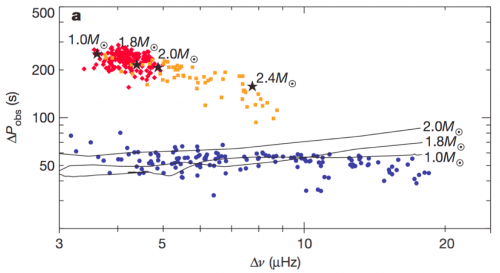Thanks to the data of the NASA Kepler satellite, an international team including Rafael Garcia of the Astrophysical Department at CEA-Irfu [1], succesfully probe the heart of hundreds of giant stars for the first time. The researchers used stellar seismology to analyze very small oscillations in surface brightness to infer the characteristics of the heart of the stars. In the large sample studied, they have managed to distinguish where the nuclear fusion reactions take place, in the core of the stars or in a surrounding shell. This is a major discovery for the understanding of the stars because so far nothing helped the astronomers to isolate these evolutionary stages corresponding to a different stage in the life of a star. The results are published in the journal Nature of March 31, 2011.
 |
The concert of red giants (mp3) Listen to the vibrations of giant stars translated into audible sounds according to their actual frequencies: listen to three stars of increasing size [1'00], Crédits Daniel Huber (Univ. Sydney 2011) |
The technique of stellar seismology, usually called asteroseismology, is blooming today thanks to the very precise measurements of the brightness of the stars provided by the last generation of space missions. First, oscillations on the surface of a star were discovered on the Sun in 1960. The Sun have been deeply studied since 1995 using, for example, the GOLF instrument on board the European SoHO satellite. The same kind of oscillations have then been detected on the surface of thousands of other stars by the French Corot satellite, in orbit since late 2006, and now by the American Kepler satellite launched in March 2009. The main scientific objective of Kepler is the search for planets, but it also provides very high quality datasets to measure the variation of the surface brightness of the stars due to their internal pulsations.
The pulsations of stars are a response of their internal structure to vibrations triggered by turbulent movements near its surface. Under the action of these vibrations, all of the star resonates as a drum that produces very low oscillations of surface brightness. The analysis of these oscillations can then be use to probe the interior of stars just as seismologist do on Earth after an earthquake.
|
Computer model of the vibrations of red giant stars. Turbulent movements at the surface of the star trigger these vibrations. All of the Star then resonates like a drum. The colours represent the "hollow" and "bumps" of these vibrations. The amplitude of oscillations has been increased and the duration reduced to make them more visible. The actual time is several hours. The second scene represents a zoom inside the core. The analysis of these oscillations allows probing the Interior of red giant stars down to the central core and discover way the energy is produced. Credits: Pieter Degroote, K.U. Leuven, Belgium. (if the vidéo does not display, click here). |
Red giant represent an advanced stage of the evolution of a star. This will be the future of our star, the Sun, in about 6 billion years. First, when the primary fuel, the hydrogen is completely burned in the centre, the nuclear reactions move to more outer layers. The star then swells and becomes giant and red because the outer regions cool down when dilating. At the same time, the central regions without an energy source that balance the gravity, contract. In a second stage, when the core of the star becomes sufficiently dense, it is helium that may enter into fusion at the centre if the star is massive enough. Up to now, astronomers had no way to distinguish between these two very different stages of the life of a star, because from the outside, both stages looked the same.
Using 13-month long datasets of nearly 400 red giant stars obtained by the Kepler satellite, scientists have finally break the secret. Studying the periodic variations in the light of the stars each one corresponding to an individual vibration, they were able to distinguish those relating to the outer layers ( acoustic waves) of those relating to the heart of the star ( gravity waves).

The observation of the gravity-mode periods in the giant stars shows two very different groups, which allows for the first time to separate the evolutionary state of these stars without ambiguity. Indeed, the gravity-mode periods of the stars that burn only hydrogen in a shell have periods around 50 seconds (blue points). Stars who burn also helium in the core have g-mode periodicities in a range of 100 to 300 seconds (red and orange points). The values shown are the masses of the stars (in solar masses) according to theoretical predictions. In the last group, the less massive stars probably start burning their helium quickly in a Flash (red points) while the more massive ones starts the Helium fusion more slowly (orange points). Crédits Kepler/NASA
On the 400 stars observed, the periodicities of the gravity modes are divided into two distinct categories: the first group showed a period of about 50 - 60 seconds while the second had periods of around 100 - 300 seconds. Comparing with theoretical predictions, scientists have concluded that they in fact observed red giant stars with a very different inner core. The stars showing short periods had a core where hydrogen was already exhausted and they then burn their hydrogen in a shell. The seconds were in a more advanced stage of evolution burning helium in their cores. Astronomers were even able to distinguish that in this second group, the burning of helium probably started differently according to the mass of the star: the less massive could burn their helium very quickly in a “flash" while only the most massive burnt their Helium more slowly. It is the first time that astronomers distinguished these very different stages of evolution.
" It is a true revolution ," says Rafael Garcia's of the Astrophysics Department of CEA-Irfu, member of the Kepler Asteroseismic Science Consortium (KASC) " thanks to these oscillating modes, we can reconstruct what happens at the core of these giants isolating very clearly two groups of stars: the red giant stars that burn hydrogen in a shell and those more advanced that burn helium in the centre. It is almost miraculous to see directly what will happen to our Sun in a few billion years". Only one single giant star could be studied so far under the same conditions; thousands will be accessible by Kepler which will remain in orbit until 2013.
Contact :
« Gravity modes as a way to distinguish between hydrogen- and helium-burning red giant stars »
Bedding et al. (2011) published in Nature magazine of 31 March 2011 (for an electronic version  file PDF)
file PDF)
see - the CNRS-CEA press-release (31 March 2011)
- the Sydney university press release (31 March 2011)
- the Leuven university press release (31 March 2011)
- the news of Paris-Meudon observatory (31 March 2011)
voir aussi - "Astronomers take the pulse of a giant star" (17 March 2011)
- "Asteroseismology and magnetic activity" (27 August 2010)
- "Starquakes: first asteroseismology results from the KEPLER satellite" (1 March 2010)
- "Pulsations d'étoiles" (20 Octobre 2009, in French)
Notes :
[1] The Kepler asterosismology scientific consortium (KASC) is an international group of scientists with an important participation from Arhus university (Denmark), the Leuven Astrophysical Institute (Belgium), the Birmigham university (U.K.), the Paris-Meudon Observatory (LESIA-Meudon, France), the Astrophysical Space Institute (Orsay, France) and the Astrophysical Department of CEA-Irfu (Saclay, France). The funding of the Kepler Mission is provided by NASA. The authors thank the Kepler team behind this mission .
Redaction: R. Garcia, J.M. Bonnet-Bidaud
• Structure and evolution of celestial bodies
• Institute of Research into the Fundamental Laws of the Universe • Department of Astrophysics (DAp) // UMR AIM
